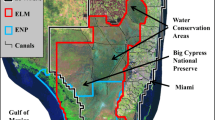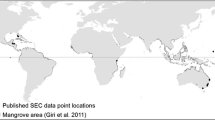Abstract
Ecological (poleward) regime shifts are a predicted response to climate change and have been well documented in terrestrial and more recently ocean species. Coastal zones are amongst the most susceptible ecosystems to the impacts of climate change, yet studies particularly focused on mangroves are lacking. Recent studies have highlighted the critical ecosystem services mangroves provide, yet there is a lack of data on temporal global population response. This study tests the notion that mangroves are migrating poleward at their biogeographical limits across the globe in line with climate change. A coupled systematic approach utilising literature and land surface and air temperature data was used to determine and validate the global poleward extent of the mangrove population. Our findings indicate that whilst temperature (land and air) have both increased across the analysed time periods, the data we located showed that mangroves were not consistently extending their latitudinal range across the globe. Mangroves, unlike other marine and terrestrial taxa, do not appear to be experiencing a poleward range expansion despite warming occurring at the present distributional limits. Understanding failure for mangroves to realise the global expansion facilitated by climate warming may require a focus on local constraints, including local anthropogenic pressures and impacts, oceanographic, hydrological, and topographical conditions.




Similar content being viewed by others
References
Bartsch, I., Wiencke, C. & Laepple, T. 2012. Global seaweed biogeography under a changing climate: the prospected effects of temperature. Seaweed Biology: Novel Insights into Ecophysiology, Ecology and Utilization, pp. 47–66.
BOM 2014. Bureau of Meteorology. Monthly mean minimum temperature: Corner Inlet (Yanakie). Available: http://www.bom.gov.au/jsp/ncc/cdio/weatherData/av?p_nccObsCode=38&p_display_type=dataFile&p_startYear=&p_c=&p_stn_num=085301. Accessed 22 Oct 2014
Boon, P.I., T. Allen, J. Brook, et al. 2011. Victorian Saltmarsh Study: mangroves and coastal saltmarsh of Victoria: distribution, condition, threats and management. Melbourne: Institute for Sustainability and Innovation, Victoria University.
Burrows, Michael T, David S Schoeman, Lauren B Buckley, Pippa Moore, Elvira S Poloczanska, Keith M Brander, Chris Brown, et al. 2011. The pace of shifting climate in marine and terrestrial ecosystems. Science 334(6056): 652–55. doi:10.1126/science.1210288.
Cartron, J.-L.E., Ceballos, G., Felger, R.S. (eds) 2005. Biodiversity, ecosystems, and conservation in Northern Mexico. Oxford University Press.
Cavanaugh, K.C., and E. Al. 2014. Reply to Giri and Long: freeze-mediated expansion of mangroves does not depend on whether expansion is emergence or reemergence. Proceedings of the National Academy of Sciences 111: E1449–E1449.
Cavanaugh, K.C., J.R. Kellner, A.J. Forde, D.S. Gruner, J.D. Parker, W. Rodriguez, and I.C. Feller. 2014. Poleward expansion of mangroves is a threshold response to decreased frequency of extreme cold events. Proceedings of the National Academy of Sciences of the United States of America 111: 723–727.
Clusener, M., and S.W. Breckle. 1987. Reasons for the limitation of mangrove along the west coast of northern Peru. Vegetation: 173–177.
Costanza, R., R. de Groot, P. Sutton, S. van der Ploeg, S.J. Anderson, I. Kubiszewski, S. Farber, and R.K. Turner. 2014. Changes in the global value of ecosystem services. Global Environmental Change 26: 152–158.
Crimp, Steven Jeffery, Bangyou Zheng, Nirav Khimashia, David Lyon Gobbett, Scott Chapman, Mark Howden, and Neville Nicholls. 2016. Recent changes in southern Australian frost occurrence: implications for wheat production risk. Crop and Pasture Science 67(8):801.
Dahdouh-Guebas, F., and N. Koedam. 2001. Are the northernmost mangroves of West Africa viable?—a case study in Banc d’ Arguin National Park. Mauritania. Hydrobiologia: 241–253.
Dahdouh-Guebas, F., L.P. Jayatissa, D. Di Nitto, J.O. Bosire, D. Lo Seen, and N. Koedam. 2005. How effective were mangroves as a defence against the recent tsunami? Current Biology: CB 15: R443–R447.
Daidu, F., and L. Congxian. 2006. Complexities of China’ s Coast in Response to Climate Change. 2: 54–58.
De Lange, W.P. & de lange, P.J. (1994) An appraisal of factors controlling the latitudinal distribution of mangrove (Avicannia marina var. resinifera) in New Zealand. Journal of Coastal Research 10, 539–548.
Duke, N.C., J.A.H. Benzie, J.A. Goodall, and E.R. Ballment. 1998. Genetic structure and evolution of species in the mangrove genus Avicennia (Avicenniaceae ) in the Indo-West Pacific. Evolution 52: 1612–1626.
Ellis, William L., Justin W. Bowles, Amy A. Erickson, Nate Stafford, Susan S. Bell, and Melanie Thomas. 2006. Alteration of the chemical composition of mangrove (Laguncularia racemosa) leaf litter fall by freeze damage. Estuarine, Coastal and Shelf Science 68(1–2):363–371.
Galal, Nasser. 2007. National Action Plan for the Conservation of Mangroves in Egypt. Ministry of Agriculture and Land Reclamation, Egyptian Government, Egypt. p 469.
Gilman, E.L., J. Ellison, N.C. Duke, and C. Field. 2008. Threats to mangroves from climate change and adaptation options: a review. Aquatic Botany 89: 237–250.
Giri, C., E. Ochieng, L.L. Tieszen, Z. Zhu, A. Singh, T. Loveland, J. Masek, and N. Duke. 2011. Status and distribution of mangrove forests of the world using earth observation satellite data. Global Ecology and Biogeography 20: 154–159.
Giri, C.P., and J. Long. 2014. Mangrove reemergence in the northernmost range limit of eastern Florida. Proceedings of the National Academy of Sciences of the United States of America 111: E1447–E1448.
Harris, L., S. Holness, R. Nel, A.T. Lombard, and D. Schoeman. 2013. Intertidal habitat composition and regional-scale shoreline morphology along the Benguela coast. Journal of Coastal Conservation 17: 143–154.
Jacobson, Andrew, Jasjeet Dhanota, Jessie Godfrey, Hannah Jacobson, Zoe Rossman, Andrew Stanish, Hannah Walker, and Jason Riggio. 2015. A novel approach to mapping land conversion using Google Earth with an application to East Africa. Environmental Modelling & Software 72:1–9.
Ji, Luyan, Peng Gong, Xiurui Geng, and Yongchao Zhao. 2015. Improving the accuracy of the water surface cover type in the 30 m FROM-GLC product. Remote Sensing 7(10): 13507–13527. doi:10.3390/rs71013507.
Khalil, A.S.M. 2004. Status of mangroves in the Red Sea and Gulf of Aden. PERSGA Technical Series No. 11.
Knight, J.M., P.E.R. Dale, R.J.K. Dunn, G.J. Broadbent, and C.J. Lemckert. 2008. Patterns of tidal flooding within a mangrove forest: Coombabah Lake, Southeast Queensland, Australia. Estuarine, Coastal and Shelf Science 76(3): 580–593. doi:10.1016/j.ecss.2007.07.044.
Krauss, K.W., C.E. Lovelock, K.L. McKee, L. López-Hoffman, S.M.L. Ewe, and W.P. Sousa. 2008. Environmental drivers in mangrove establishment and early development: a review. Aquatic Botany 89: 105–127.
Long, Jordan, Chandra Giri, Jurgenne Primavera, and Mandar Trivedi. 2016. Damage and recovery assessment of the Philippines’ mangroves following Super Typhoon Haiyan. Marine Pollution Bulletin 109(2):734–743.
Lovelock, C.E., B.K. Sorrell, N. Hancock, Q. Hua, and A. Swales. 2010. Mangrove forest and soil development on a rapidly accreting shore in New Zealand. Ecosystems 13: 437–451.
Lovelock, C.E., K.W. Krauss, M.J. Osland, R. Reef, and M.C. Ball. 2016. The physiology of mangrove trees with changing climate. In Tropical tree physiology: adaptations and responses in a changing environment, ed. G. Goldstein and S.L. Santiago, 149–179. Cham: Springer International Publishing.
Macnae, W. 1963. Mangrove swamps in South Africa. Journal of Ecology 51: 1–25.
McMillan, Calvin. 1971. Environmental factors affecting seedling establishment of the Black Mangrove on the Central Texas Coast. Ecology: Ecological Society of America 52(5): 927–930. doi:10.2307/1936046.
Morrisey, D.J., A. Swales, S. Dittmann, M.A. Morrison, C.E. Lovelock, and C.M. Beard. 2010. The ecology and management of temperate mangroves. Oceanogr. Mar. Biol. Ann. Rev. 48: 43–160.
Parmesan, C., and G. Yohe. 2003. A globally coherent fingerprint of climate change impacts across natural systems. Nature 421: 37–42.
Ploton, Pierre, Raphaël Pélissier, Christophe Proisy, Théo Flavenot, Nicolas Barbier, S. N. Rai, and Pierre Couteron. 2012. Assessing aboveground tropical forest biomass using Google Earth canopy images. Ecological Applications 22(3):993–1003.
Poloczanska, E.S., C.J. Brown, W.J. Sydeman, W. Kiessling, D.S. Schoeman, P.J. Moore, K. Brander, J.F. Bruno, L.B. Buckley, M.T. Burrows, C.M. Duarte, B.S. Halpern, J. Holding, C.V. Kappel, M.I. O’Connor, J.M. Pandolfi, C. Parmesan, F. Schwing, S.A. Thompson, and A.J. Richardson. 2013. Global imprint of climate change on marine life. Nature Climate Change 3: 919–925.
Quisthoudt, K., J. Adams, A. Rajkaran, F. Dahdouh-Guebas, N. Koedam, and C.F. Randin. 2013. Disentangling the effects of global climate and regional land-use change on the current and future distribution of mangroves in South Africa. Biodiversity and Conservation 22: 1369–1390.
Quisthoudt, K., N. Schmitz, C.F. Randin, F. Dahdouh-Guebas, E.M.R. Robert, and N. Koedam. 2012. Temperature variation among mangrove latitudinal range limits worldwide. Trees 26: 1919–1931.
Reef, R, Slot, M, Motro, U et al. 2016. The effects of CO2 and nutrient fertilisation on the growth and temperature response of the mangrove Avicennia germinans. Photosynthesis Research 2.
Saintilan, N. & Rogers, K. 2009. Coastal saltmarsh vulnerability to climate change in SE Australia. NSW Coastal Conference
Saintilan, N., N.C. Wilson, K. Rogers, A. Rajkaran, and K.W. Krauss. 2014. Mangrove expansion and salt marsh decline at mangrove poleward limits. Global Change Biology 20: 147–157.
Soares, M.L.G., G.C.D. Estrada, V. Fernandez, and M.M.P. Tognella. 2012. Southern limit of the Western South Atlantic mangroves: assessment of the potential effects of global warming from a biogeographical perspective. Estuarine, Coastal and Shelf Science 101: 44–53.
Spalding, M, Kainuma, M, Collins, L. 2010. World Atlas of Mangroves. A collaborative project of ITTO, ISME.
Steinke, T.D., and C.J. Ward. 2003. Use of plastic drift cards as indicators of possible dispersal of propagules of the mangrove Avicennia marina by ocean currents. African Journal of Marine Science 25 (May 2013): 169–176. doi:10.2989/18142320309504007.
Tan, K.C., H.S. Lim, M.Z. MatJafri, and K. Abdullah. 2010. Landsat data to evaluate urban expansion and determine land use/land cover changes in Penang Island, Malaysia. Environmental Earth Sciences 60: 1509–1521.
Wakushima, S., S. Kuraishi, and N. Sakurai. 1994. Soil salinity and pH in Japanese mangrove forests and growth of cultivated mangrove plants in different soil conditions. Journal of Plant Research 41: 39–46.
Wang, Wenqing, Siyang You, Yunbo Wang, Li Huang, and Mao Wang. 2011. Influence of frost on nutrient resorption during leaf senescence in a mangrove at its latitudinal limit of distribution. Plant and Soil 342(1–2):105–115.
Woodroffe, C.D. & Grindrod, J. 1991. Mangrove biogeography: and sea-level change environmental the role of Quaternary. 18, 479–492.
Acknowledgements
This work was supported by the CSIRO Flagship Marine and Coastal Carbon Biogeochemical Cluster (Coastal Carbon Cluster) with funding from the CSIRO Flagship Collaboration Fund.
Author information
Authors and Affiliations
Corresponding author
Additional information
Communicated by Cathleen Wigand
Electronic Supplementary Material
ESM 1
(DOCX 17 kb)
Rights and permissions
About this article
Cite this article
Hickey, S.M., Phinn, S.R., Callow, N.J. et al. Is Climate Change Shifting the Poleward Limit of Mangroves?. Estuaries and Coasts 40, 1215–1226 (2017). https://doi.org/10.1007/s12237-017-0211-8
Received:
Revised:
Accepted:
Published:
Issue Date:
DOI: https://doi.org/10.1007/s12237-017-0211-8




